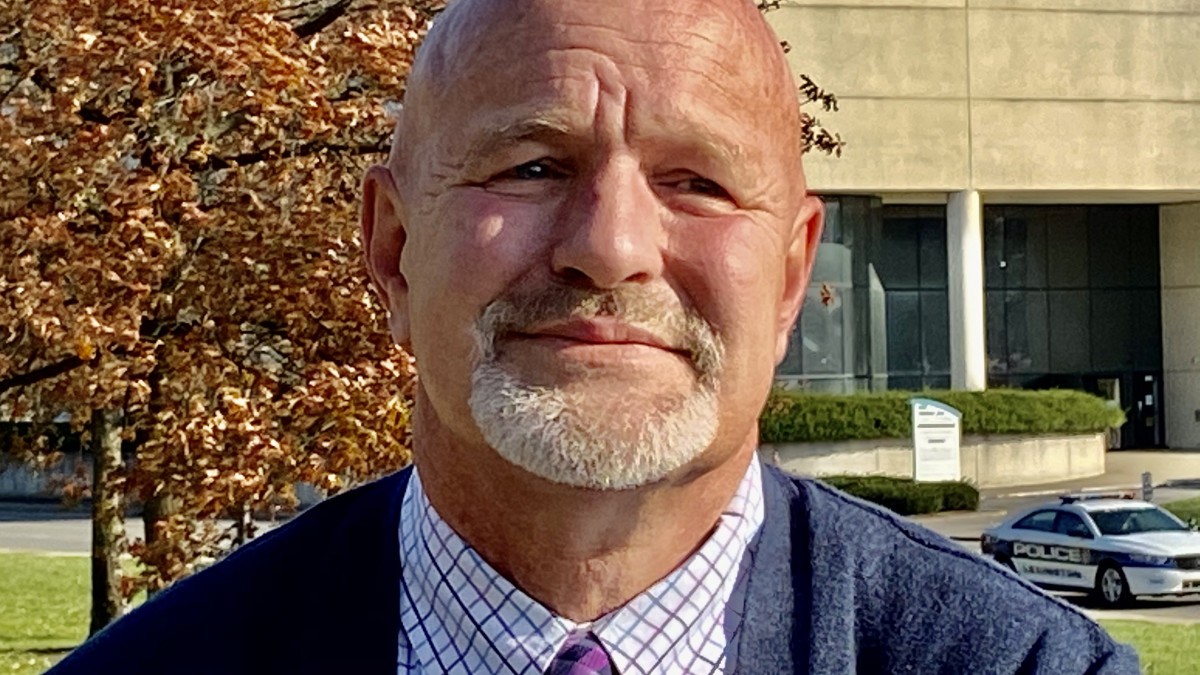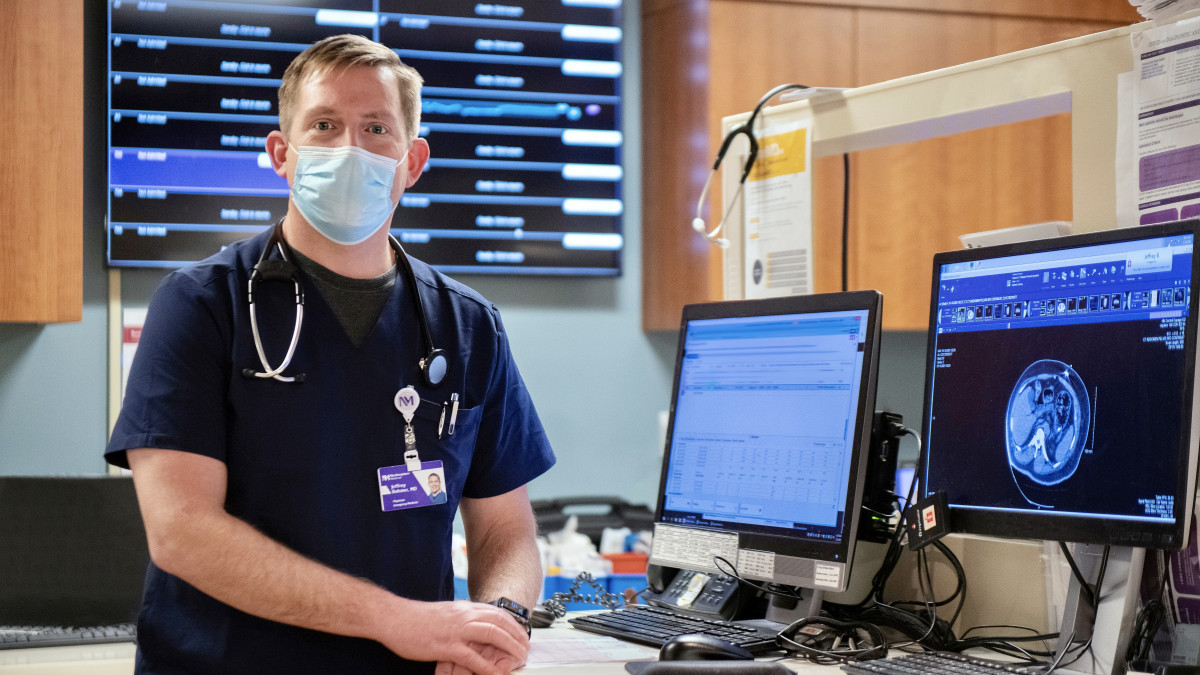The paramedics have radioed in to say the victim of a vicious car crash is unresponsive and his vital signs are unstable. So when they wheel the man into the emergency room, the nurse skips the usual triage process and the patient is rushed back to the room where Jeff Bohmer ’95 is ready to practice his ABCs.
“Those are the three first steps we take to stabilize any trauma patient,” said Bohmer, an emergency room physician and vice chairman of the Emergency Department at Northwestern Medicine Central DuPage Hospital in Winfield, Illinois.
“My goal is to get them out of the emergency room, to get them to the CAT scanner, identify what the injuries are, then start consulting with the appropriate consultants and specialists who need to intervene to get them the treatment they need right now and get them on the road to recovery.”
Bohmer, like emergency room physicians everywhere, uses the ABC algorithm:

AIRWAY: Bohmer determines if the patient’s airway is open; if not, “that may mean I need to put a breathing tube down their throat into their trachea and put them on a respirator to breathe for them. Sometimes that’s not an option because they have such bad facial trauma, so we need to do … a cricothyrotomy, where we basically open up the spot right near the trachea to put a tube in.” A respiratory therapist helps with the procedure.
 BREATHING: “Then we put them on a ventilator, make sure we can actually get them breathing on their own.”
BREATHING: “Then we put them on a ventilator, make sure we can actually get them breathing on their own.”
By now, the hospital has paged a trauma surgeon, the blood bank, the radiology team and the in-house pharmacist – all of whom must be ready when Bohmer needs them. He may eventually call other specialists too. Three nurses are with him – one to pull medicines, one to get the IV line going and administer the meds and one to record the action.
 CIRCULATION: Bohmer and his team measure blood pressure and examine visible, bleeding wounds to “establish whether or not the patient has enough cardiac drive and has enough blood in their system, really, to be able to circulate and provide life to their vital organs,” he said. When the team is confident that is happening – a result of the first three steps, which happen simultaneously – they address other issues.
CIRCULATION: Bohmer and his team measure blood pressure and examine visible, bleeding wounds to “establish whether or not the patient has enough cardiac drive and has enough blood in their system, really, to be able to circulate and provide life to their vital organs,” he said. When the team is confident that is happening – a result of the first three steps, which happen simultaneously – they address other issues.
 DISABILITY: The medical team assesses whether something else, more than the trauma, is affecting the patient. Did the car accident and resulting trauma occur because the patient was having a heart attack or a stroke?
DISABILITY: The medical team assesses whether something else, more than the trauma, is affecting the patient. Did the car accident and resulting trauma occur because the patient was having a heart attack or a stroke?
 EXPOSURE: When the patient is stabilized, the team exposes him to search for other signs of trauma. Does he have a broken ankle? Femur? Back?
EXPOSURE: When the patient is stabilized, the team exposes him to search for other signs of trauma. Does he have a broken ankle? Femur? Back?
With breathing and circulation stabilized, the patient can be taken to the CAT scanner, which will reveal injuries to the brain, skull, spine and internal organs and vessels. Though he is not a radiologist, who can identify subtler injuries, Bohmer can look at a CAT scan and recognize bleeding on the brain or in the abdomen, and he’ll inform the trauma surgeon. If he detects brain or spine injuries, he calls a neurosurgeon.
“They’re still my patient until they leave the emergency room,” Bohmer said. “The trauma surgeon will assume some of the care of that patient once they arrive,” which is required within 30 minutes of the hospital’s page. Together, Bohmer and the trauma surgeon decide on a course of action. “They have their expertise and I have my expertise, so we share the duties once they come into the emergency room,” he said. “They also realize that I’m also managing eight or nine other patients at the same time.”
To manage the care of so many people at once, “I’m always having to run a checklist in my mind,” he said. “The way our emergency service is set up is that I’m responsible for 10 rooms, so I make a checklist of who’s in what room and what am I waiting on for that person, what does that person need and what am I anticipating with that patient.”
Bohmer sees about 5,000 patients a year. On a recent shift, he saw an eight-week-old infant who had COVID-19; a 93-year-old woman who had lost so much blood to a bleeding ulcer that she needed a transfusion; a man having a heart attack that was not revealed by an EKG; and a 30-year-old woman who fell while walking her dog and had blood on her brain. He occasionally sees victims of violence but, when possible, paramedics take such patients to Level 1 trauma centers; Central DuPage is Level 2.
“We see everyone who walks in the door, no matter what their complaint is or what their underlying issue is. … It’s a pretty wide breadth, which is what I like about it,” he said. “I don’t know what I’m seeing when I walk into the shift every day.”
The ABC – and D and E – algorithm is prescribed by Bohmer’s advanced trauma life support certification and becomes second nature, he said. The emotional toll does not.
“I’ve learned over the years that if I’m going to be able to live my life and be able to do my job and do it well, you have to put somewhat of a façade up, a little bit of a barrier or you’ll never be able to go on to the next patient, let alone the shift,” he said.
For the emotionally wrenching cases, such as the chronically ill 10-year-old who died despite the team’s long resuscitation efforts, the hospital invites the medical professionals to attend debriefing sessions with a social worker. Still, Bohmer knows he’ll never forget certain cases: The 14-year-old who died from an undetected congenital heart defect (“this was 15 years ago and it still makes my heart race when I think about this”). The woman attacked by a pack of stray dogs.
“There are certain ones who definitely stick out that I’ll take to the day I die,” he said. “And those are the ones that shape us and make us who we are.”
(Photo: Northwestern Medicine)
DePauw Magazine
Spring 2021
 Leaders the World Needs
Leaders the World Needs First Person by Nate Spangle ’19
First Person by Nate Spangle ’19  The Bo(u)lder Question
The Bo(u)lder Question  How to reckon with the past
How to reckon with the past How to die peacefully
How to die peacefully How to be creative in a crisis
How to be creative in a crisis How to do well by doing good
How to do well by doing good How to argue before the Supreme Court
How to argue before the Supreme Court How to run for your life
How to run for your life How to write a love letter
How to write a love letter How to create art
How to create art How to find Jimmy Hoffa
How to find Jimmy Hoffa How to break into TV
How to break into TV How to be happy
How to be happy  DePauw Magazine: The How-To Issue
DePauw Magazine: The How-To Issue Town-gown: How to find common ground on common ground
Town-gown: How to find common ground on common ground How to write a bestseller
How to write a bestseller How to save a life
How to save a life
DePauw Stories
A GATHERING PLACE FOR STORYTELLING ABOUT DEPAUW UNIVERSITY
Browse other stories
-
Athletics
-
Women's Golf - Williams Selected Academic All-America®
-
Football - DePauw-Record 190 Student-Athletes Named to NCAC's Dr. Gordon Collins Scholar-Athlete Honor Roll
-
Football - 336 Students Named to 2025 Spring Tiger Pride Honor Roll
More Athletics
-
-
News
-
Outstanding scholars named to Spring 2025 Dean's List
-
Alumni News Roundup - June 6, 2025
-
Transition and Transformation: Inside the First-Year Experience
More News
-
-
People & Profiles
-
11 alums make list of influential Hoosiers
-
DePauw welcomes Dr. Manal Shalaby as Fulbright Scholar-in-Residence
-
DePauw Names New Vice President for Communications and Strategy and Chief of Staff
More People & Profiles
-
-
Have a story idea?
Whether we are writing about the intellectual challenge of our classrooms, a campus life that builds leadership, incredible faculty achievements or the seemingly endless stories of alumni success, we think DePauw has some fun stories to tell.
-
Communications & Marketing
101 E. Seminary St.
Greencastle, IN, 46135-0037
communicate@depauw.eduNews and Media
-
News media: For help with a story, contact:
Bob Weaver, Senior Director of Communications.
bobweaver@depauw.edu.